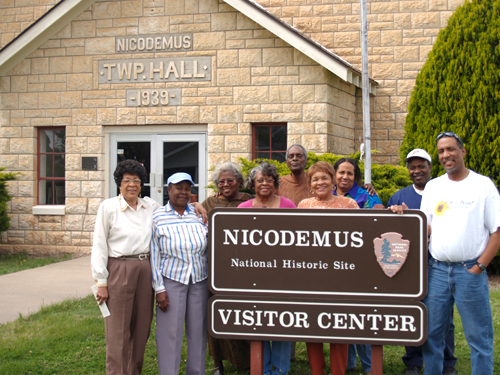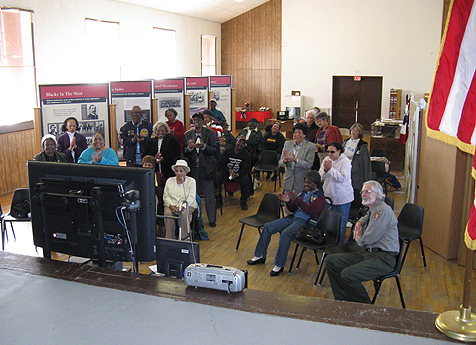Address: 304 Washington Avenue, Nicodemus KS 67625
Phone: 785.839.4321
Website: www.nps.gov/nico/
 Nicodemus is a finalist for the 8
Wonders of Kansas History because it is the oldest and only remaining all-black
town west of the
Nicodemus is a finalist for the 8
Wonders of Kansas History because it is the oldest and only remaining all-black
town west of the
"In northwestern Kansas is a town that stands for freedom and family. It is a special place where roots run deep and every building has a story connecting family and friends. Located just off Highway 24 in Graham County, the town of Nicodemus is a small cluster of peaceful historic buildings, across the road from wheat fields that stretch to the northern horizon.
In 1877 Nicodemus was the Promised Land to African Americans who were determined to make the most of new opportunities after the Civil War ended. With courage and perseverance but few material possessions, they made a new life for themselves in a challenging geographical setting. With an arid climate and sandy soil, most of the almost treeless land was virgin prairie. "The valley of the south fork of the Solomon is not, beyond Stockton, the most fertile or beautiful body of land on earth," wrote Clayton Fraser.
 |
| District No. 1 Nicodemus School. Photo KSF |
As Nicodemus settler H.L. Vanderwall wrote in the Cleveland Gazette in 1884, "About six years ago we saw that the day for a black man to get property in the South was at an end and Ku-Klux rule commenced." In 1877, one week prior to the formal end of Reconstruction, six black men and one white man registered the Nicodemus Town Company with the Kansas Secretary of State for the purpose of developing and selling lots within the proposed town of Nicodemus. On April 16, 1877, the first handbill advertising Nicodemus appeared. A leaflet entitled "The Largest Colored Colony in America!" said that by September 1, the colony would have houses erected and mercantile business opened for settlers.
Willina Hickman, a member of the third group to arrive in the spring of 1878, recalled her disappointment, "I looked with all the eyes I had. 'Where is Nicodemus? I don't see it.' My husband pointed out various smokes coming out of the ground and said, 'That is Nicodemus.' The families lived in dugouts....The scenery was not at all inviting, and I began to cry."

A crowd gathers to watch Barack Obama's Inauguration on TV at the Visitors Center. Photo courtesy Nicodemus National Historic Site
With grit and determination, newcomers to Nicodemus dug out homes in the bluffs of the Solomon River or in hillsides. With only a few belongings and basic tools, they gradually made a life for themselves. By mid 1886, Nicodemus had fifteen stone buildings, fourteen farm buildings, seven sod structures, two churches, two hotels, two stables, one newspaper, one schoolroom, one land company, one bank, one society hall and one hundred and fifty permanent residents. The next year, the town residents built their first formal schoolhouse, a two-story four-room frame structure located near the center of town.
A promised railway never materialized; the Union Pacific bypassed Nicodemus by six miles despite the town's lobbying. Drought, grasshopper plagues and hard times followed. Residents took wage-paying jobs in towns. Many moved away to nearby Bogue, which had a railroad depot, or further west. Once bustling Nicodemus became a rural farm town. |
| Historic photo of Nicodemus. Photo courtesy Nicodemus National Historic Site |